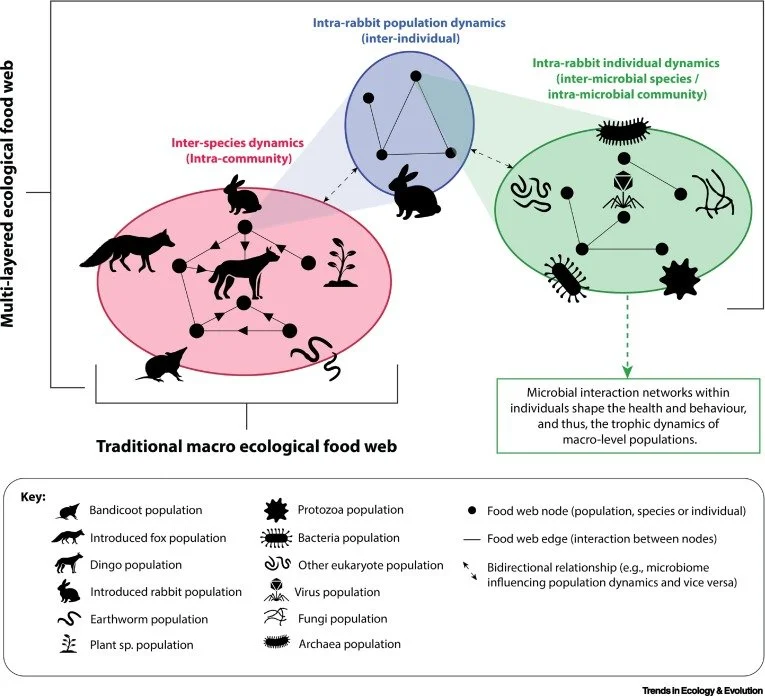Nested Food Webs!
Nested food webs
While writing Invisible Friends, it occurred to me that microbial communities were not only nested within organisms forming a ‘holobiont’, but also that the microbial interactions that occurred within individuals could influence macro-dynamics across trophic levels. In other words, the interplay between the microscopic communities and their hosts could potentially ripple through the energy pyramid, influencing the population dynamics of much larger beings.
“Perhaps more radically, there is also an argument to re-envision the pyramid completely in light of holobiont research. After all, from a holobiont perspective, where microbes and hosts together act as a whole, trophic levels become fuzzy, and microbes become central to each level in the pyramid.”
—From Invisible Friends (2023)
I took this idea to my friend and colleague Martin Breed and we had a few late-night/early morning (I was still in the UK at this point) natters over Zoom to iron out the details. We concluded that it was better to think about this in terms of food webs rather than energy pyramids – which is a tad outdated.
And so, the concept of ‘nested food webs’ was born.
The nested food webs concept explores the layer of interactions occurring at microscopic levels, which may have profound implications for the broader ecological landscape. Microbial food webs within holobionts are part of bustling ecosystems in their own right. For instance, in a cow's gut, countless microorganisms, including bacteria and archaea like Ruminococcus and Methanobrevibacter, engage in a continuous exchange of nutrients and chemical signals. However, spider-like lunar lander viruses called ‘phages’ can also ‘hunt’ these microbes, keeping their populations in check. Collectively, these microbial interactions could significantly impact the cow’s digestion, health, and overall wellbeing. A ‘balanced’, healthy microbiome, known as eubiosis, can enhance the host’s immune function, digestion, and overall health. Conversely, an ‘imbalanced’ microbiome, or dysbiosis, can lead to various health issues, making the host more susceptible to diseases and environmental stresses.
We hypothesise that the influence of these microbial interactions extends beyond the individual host to affect macro-level food web dynamics. Consider a prey animal, such as a rabbit, with a dysbiotic gut microbiome. Its compromised health could make it slower, less vigilant, and more prone to predation by foxes. Predators might find these weakened rabbits easier targets, potentially altering predator-prey relationships and influencing the population dynamics of both rabbits and foxes. On the flip side, a healthy, eubiotic microbiome can enhance a rabbit’s resilience, making it less vulnerable to predators and thereby influencing predator population dynamics from a different perspective. But we don’t just consider the dysbiosis-eubiosis axis in nested food webs. For instance, irrespective of this axis, we know that certain microbes can influence sexual preference, feeding decisions and the desire to exercise, all of which could affect host fitness and behaviour, and thus, population dynamics.
This nested food web concept, which in some academic circles we’re calling ‘multi-layered networks’ highlights the interconnectedness of life across scales –– we’re talking food webs in food webs. The health of an individual organism can hinge on the microbial communities it harbours, which in turn can shape broader ecological interactions and processes.
Another example might go something like this: in a forest ecosystem, the roots of trees such as oaks form holobionts with mycorrhizal fungi like Rhizophagus irregularis. These fungi enhance nutrient uptake for the tree, which supports better growth and resistance to pests. Healthy trees can better support herbivores like deer, which in turn are prey for predators like wolves. Conversely, trees suffering from microbial dysbiosis or altered microbial communities might become more susceptible to infestations, leading to cascading effects throughout the macro food web.
Understanding the nested nature of food webs could lead to a more holistic approach to studying and managing ecosystems. Our framework opens avenues for new empirical investigations into complex ecological networks and provides a new lens through which to view a network’s (or food web’s) response to ecosystem changes.
Check out our new publication in Trends in Ecology and Evolution (TREE):
Food webs in food webs: the micro-macro interplay of multi-layered networks.
Find my book, Invisible Friends: How Microbes Shape Our Lives and the World Around Us here


